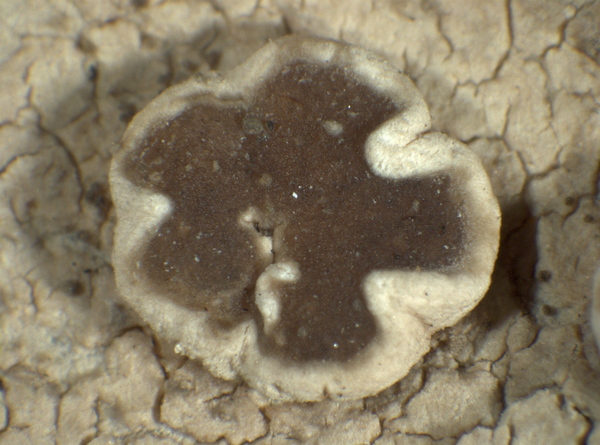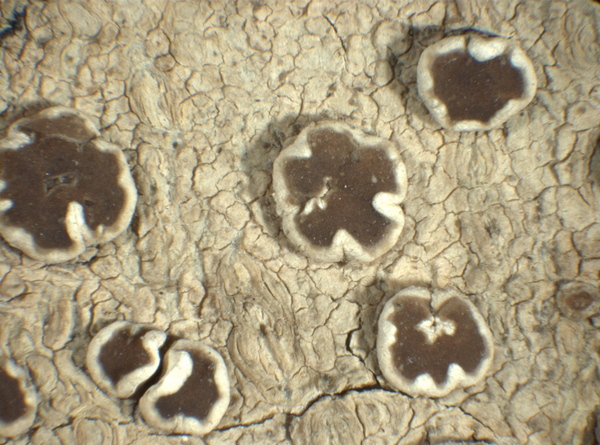Lecanora intumescens (Rebent.) Rabenh.
Deutsche Krypt.-Fl., 2: 334, 1845. Basionym: Parmelia intumescens Rebent. - Prodr. Fl. Neomarch.: 301, 1804.
Synonyms: Lecanora hispanica I. Ibáñez & Burgaz; Lecanora intumescens var. glaucorufa (Mart.) Körb.; Lecanora subfusca var. intumescens (Rebent.) Flot.; Ochrolechia parella var. tumidula (Pers.) Arnold non auct.; Ochrolechia tumidula (Pers.) Arnold non auct.; Patellaria intumescens (Rebent.) Trevis.
Distribution: N - VG (Carvalho 1997), Frl, Ven (Lazzarin 1997, 2000, Nascimbene & Caniglia 2003c, Nascimbene & al. 2007, Nascimbene 2008c), TAA (Nascimbene & Caniglia 2000b, 2002c, Nascimbene & al. 2006e, 2007b, 2022, Nimis & al. 2015), Lomb (Zocchi & al. 1997, Gheza & al. 2023), Piem (Caniglia & al. 1992, Arosio & al. 1998, Isocrono & al. 2004, 2006, 2007), Emil (Nimis & al. 1996, Tretiach & al. 2008, Benesperi 2009, Fariselli & al. 2020), Lig (Lumbsch & al. 1997, Putortì & al. 1999b, Brunialti & Giordani 2003, Giordani 2006, Giordani & Incerti 2008, Watson 2014). C - Tosc (Tretiach & Nimis 1994, Loppi & Putortì 1995b, Paoli & Loppi 2001, Frati & al. 2006b, Loppi & al. 2006, Loppi & Frati 2006, Benesperi & al. 2007, Brunialti & Frati 2010, Benesperi 2011, Nascimbene & al. 2015, Frati & Brunialti 2023), Marc (Nimis & Tretiach 1999), Umb (Ravera 1998, Nimis & Tretiach 1999, Ravera & al. 2006), Laz (Massari & Ravera 2002), Abr (Nimis & Tretiach 1999, Caporale & al. 2016, Corona & al. 2016, Gheza & al. 2021), Mol (Nimis & Tretiach 1999, Caporale & al. 2008, Ravera & al. 2010, Genovesi & Ravera 2014), Sar (Cossu 2013). S - Camp (Aprile & al. 2002, Nimis & Tretiach 2004, Brunialti & al. 2010, 2013, Garofalo & al. 2010, Ravera & Brunialti 2013), Pugl (Nimis & Tretiach 1999), Bas (Nimis & Tretiach 1999, Brodo & al. 2019), Cal (Puntillo 1996, Incerti & Nimis 2006), Si (Schicchi & al. 1997, Falco Scampatelli 2005, Brodo & al. 2019, Campisi & al. 2020).
Description: Thallus crustose, usually smooth, continuous to finely rimose in central parts, white to very pale grey, sometimes delimited by a dark prothallus. Apothecia lecanorine, 1-3 mm across, round or most often irregular in outline, slightly constricted at base, with an ochraceous brown to medium brown, at first slightly pruinose, then epruinose, flat to finally slightly convex disc and a thick, swollen, often flexuose, pruinose thalline margin. Thalline exciple without a differentiated cortex, the medullary hyphae reaching the margin, with abundant, small, yellowish crystals visible under polarized light, which are insoluble in K; epithecium orange to orange-brown, the pigment not dissolving in K, with coarse, yellowish crystals dissolving in K; hymenium colourless, 75-110 µm high; paraphyses simple or sparingly branched and anastomosing, 1.5-2.5 thick at mid-level, the apical cells up to 3.5(-4) µm wide; hypothecium colourless, not inspersed with oil droplets. Asci 8-spored, clavate, very thin-walled, with a K/I+ blue, tall tholus penetrated by a faintly amyloid apical cushion, the wall K/I-, surrounded by a blue outer layer, Lecanora-type. Ascospores 1-celled, hyaline, ellipsoid, 11-18 x 5-8 µm. Photobiont chlorococcoid. Spot tests: thallus K+ yellow (sometimes turning brownish), C-, KC-, P+ yellow to orange-red (reaction more evident in the thalline margin of apothecia), UV+ pale orange; apothecial disc P-. Chemistry: atranorin (major), chloratranorin, psoromic acid, 2'-0-demethylpsoromic acid, zeorin. Note: a cool-temperate species found on smooth subacid bark, with optimum in humid beech forests; present throughout the country, but most common in the beech forests of Central and Southern Italy.
Growth form: Crustose
Substrata: bark
Photobiont: green algae other than Trentepohlia
Reproductive strategy: mainly sexual
Commonnes-rarity: (info)
Alpine belt: absent
Subalpine belt: absent
Oromediterranean belt: absent
Montane belt: very common
Submediterranean belt: extremely rare
Padanian area: absent
Humid submediterranean belt: very rare
Humid mediterranean belt: absent
Dry mediterranean belt: absent
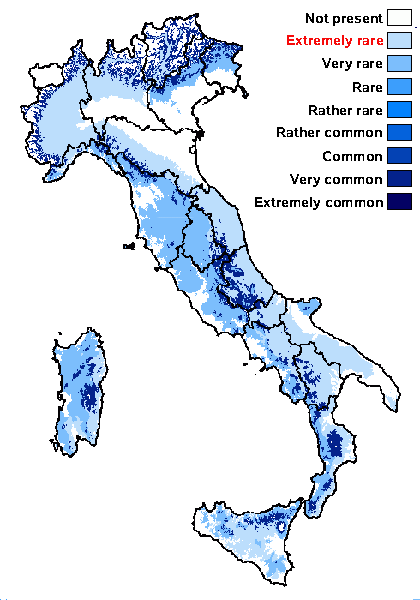
Predictive model
Herbarium samples
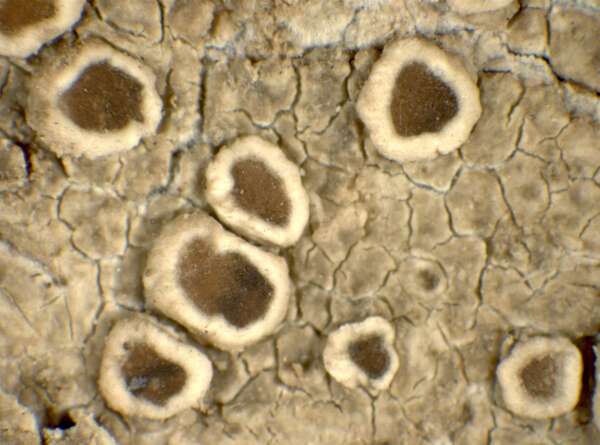

P.L. Nimis; Owner: Department of Life Sciences, University of Trieste
Herbarium: TSB (20157)
2001/12/08
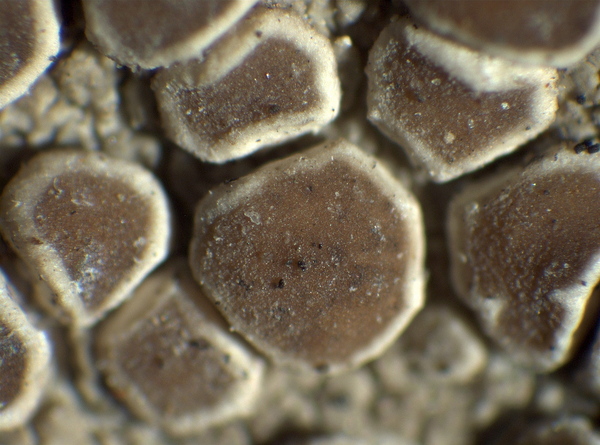

P.L.Nimis; Owner: Department of Life Sciences, University of Trieste
Herbarium: TSB (20171)
2008.03.06
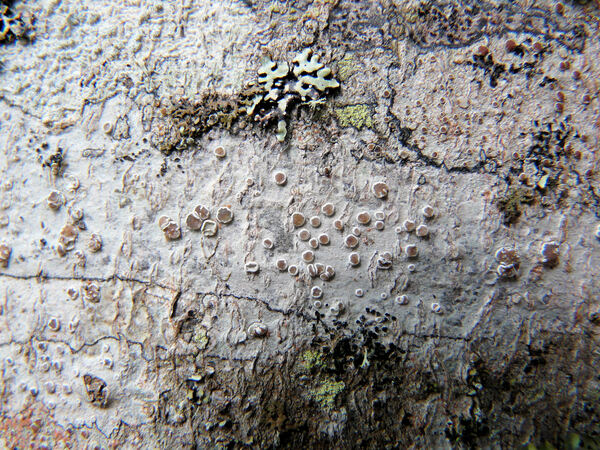

Andrea Moro; Owner: Department of Life Sciences, University of Trieste
Italia, Friuli-Venezia Giulia, UD, Comune di Sauris, Bosco della Stua presso il Lago
2008.26.08


P.L. Nimis; Owner: Department of Life Sciences, University of Trieste
Italy, Friuli Venezia Giulia, Udine, Passo del Pura, Ampezzo Carnico, 1400 m
09.09.2016


P.L. Nimis; Owner: Department of Life Sciences, University of Trieste
Italy, Friuli Venezia Giulia, Udine, Passo del Pura, Ampezzo Carnico, 1400 m
09.09.2016
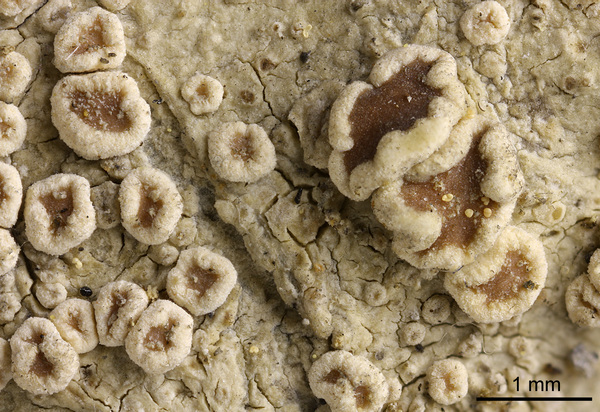

Felix Schumm – CC BY-SA 4.0
[1006], Germany, Baden-Württemberg, Schwäbische Alb, Kreis Heidenheim, Reishalde beim Dudelhof südlich von Steinheim, ca. 630 m, Buchen im Laubwald, TK 7326/1. Leg. et det. Schumm.
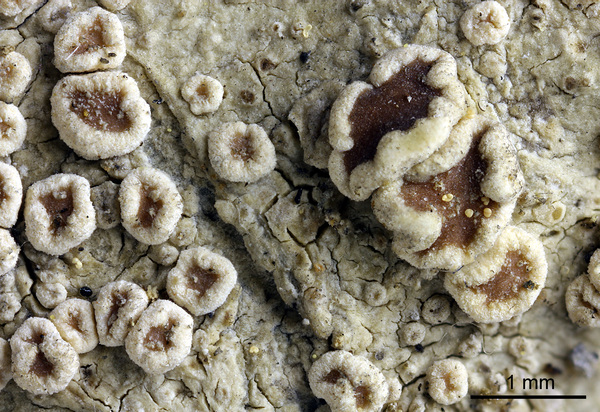

Felix Schumm – CC BY-SA 4.0
[1006], Germany, Baden-Württemberg, Schwäbische Alb, Kreis Heidenheim, Reishalde beim Dudelhof südlich von Steinheim, ca. 630 m, Buchen im Laubwald, TK 7326/1. Leg. et det. Schumm.


Felix Schumm – CC BY-SA 4.0
[1006], Germany, Baden-Württemberg, Schwäbische Alb, Kreis Heidenheim, Reishalde beim Dudelhof südlich von Steinheim, ca. 630 m, Buchen im Laubwald, TK 7326/1. Leg. et det. Schumm.
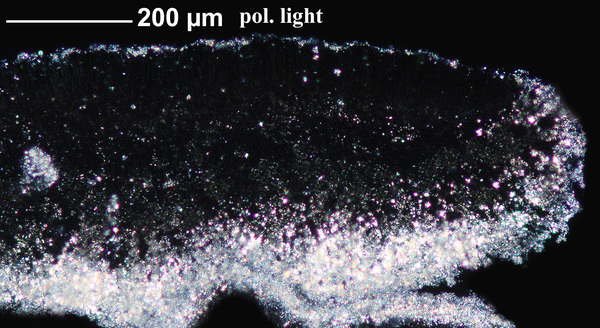

Felix Schumm – CC BY-SA 4.0
[1006], Germany, Baden-Württemberg, Schwäbische Alb, Kreis Heidenheim, Reishalde beim Dudelhof südlich von Steinheim, ca. 630 m, Buchen im Laubwald, TK 7326/1. Leg. et det. Schumm.
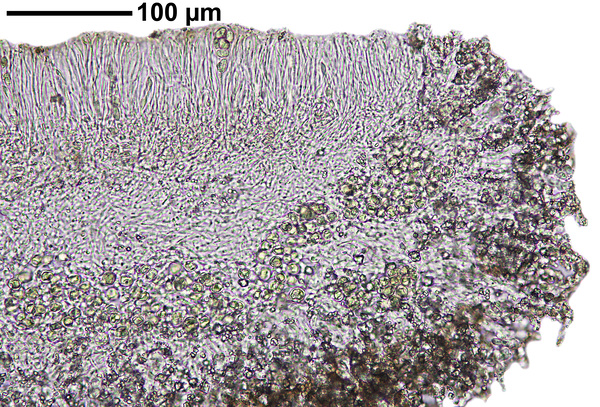

Felix Schumm – CC BY-SA 4.0
[1006], Germany, Baden-Württemberg, Schwäbische Alb, Kreis Heidenheim, Reishalde beim Dudelhof südlich von Steinheim, ca. 630 m, Buchen im Laubwald, TK 7326/1. Leg. et det. Schumm.


Felix Schumm – CC BY-SA 4.0
[1006], Germany, Baden-Württemberg, Schwäbische Alb, Kreis Heidenheim, Reishalde beim Dudelhof südlich von Steinheim, ca. 630 m, Buchen im Laubwald, TK 7326/1. Leg. et det. Schumm.


Felix Schumm – CC BY-SA 4.0
[1006], Germany, Baden-Württemberg, Schwäbische Alb, Kreis Heidenheim, Reishalde beim Dudelhof südlich von Steinheim, ca. 630 m, Buchen im Laubwald, TK 7326/1. Leg. et det. Schumm.
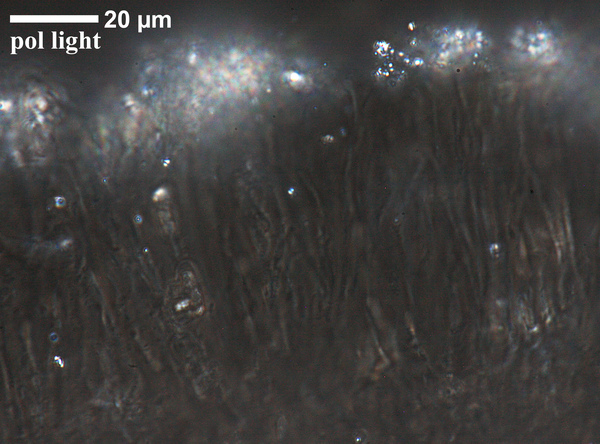

Felix Schumm – CC BY-SA 4.0
[1006], Germany, Baden-Württemberg, Schwäbische Alb, Kreis Heidenheim, Reishalde beim Dudelhof südlich von Steinheim, ca. 630 m, Buchen im Laubwald, TK 7326/1. Leg. et det. Schumm.
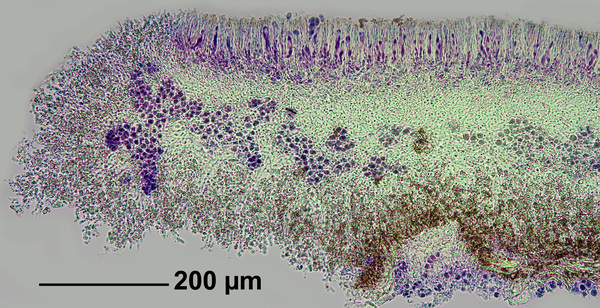

Felix Schumm – CC BY-SA 4.0
[1006], Germany, Baden-Württemberg, Schwäbische Alb, Kreis Heidenheim, Reishalde beim Dudelhof südlich von Steinheim, ca. 630 m, Buchen im Laubwald, TK 7326/1. Leg. et det. Schumm.
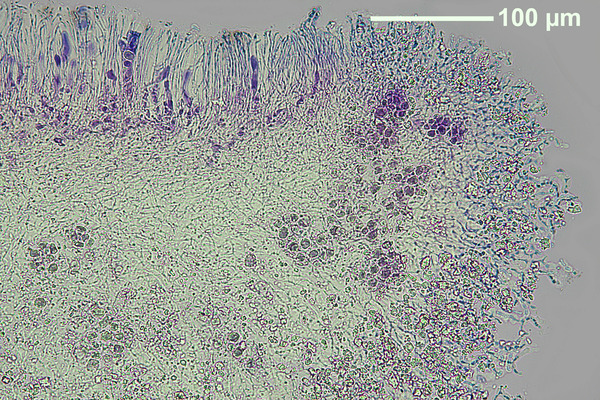

Felix Schumm – CC BY-SA 4.0
[1006], Germany, Baden-Württemberg, Schwäbische Alb, Kreis Heidenheim, Reishalde beim Dudelhof südlich von Steinheim, ca. 630 m, Buchen im Laubwald, TK 7326/1. Leg. et det. Schumm.
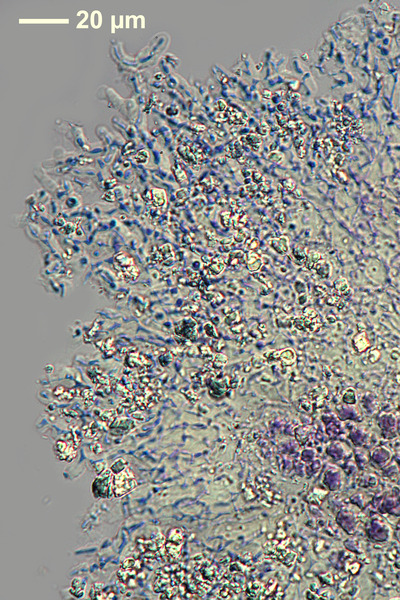

Felix Schumm – CC BY-SA 4.0
[1006], Germany, Baden-Württemberg, Schwäbische Alb, Kreis Heidenheim, Reishalde beim Dudelhof südlich von Steinheim, ca. 630 m, Buchen im Laubwald, TK 7326/1. Leg. et det. Schumm.
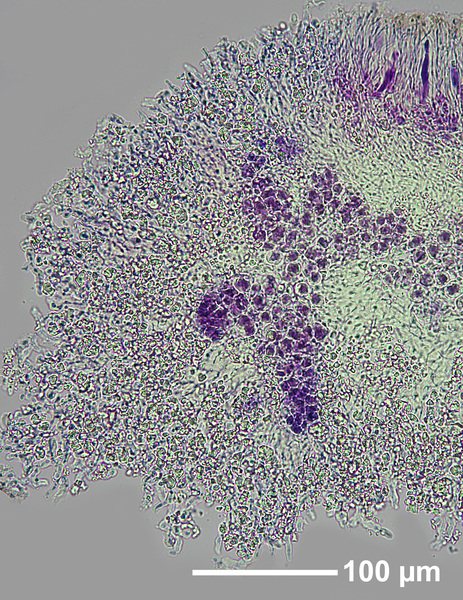

Felix Schumm – CC BY-SA 4.0
[1006], Germany, Baden-Württemberg, Schwäbische Alb, Kreis Heidenheim, Reishalde beim Dudelhof südlich von Steinheim, ca. 630 m, Buchen im Laubwald, TK 7326/1. Leg. et det. Schumm.
Growth form: Crustose
Substrata: bark
Photobiont: green algae other than Trentepohlia
Reproductive strategy: mainly sexual
Commonnes-rarity: (info)
Alpine belt: absent
Subalpine belt: absent
Oromediterranean belt: absent
Montane belt: very common
Submediterranean belt: extremely rare
Padanian area: absent
Humid submediterranean belt: very rare
Humid mediterranean belt: absent
Dry mediterranean belt: absent

Predictive model
| Herbarium samples |


P.L. Nimis; Owner: Department of Life Sciences, University of Trieste
Herbarium: TSB (20157)
2001/12/08


P.L.Nimis; Owner: Department of Life Sciences, University of Trieste
Herbarium: TSB (20171)
2008.03.06


Andrea Moro; Owner: Department of Life Sciences, University of Trieste
Italia, Friuli-Venezia Giulia, UD, Comune di Sauris, Bosco della Stua presso il Lago
2008.26.08


P.L. Nimis; Owner: Department of Life Sciences, University of Trieste
Italy, Friuli Venezia Giulia, Udine, Passo del Pura, Ampezzo Carnico, 1400 m
09.09.2016


P.L. Nimis; Owner: Department of Life Sciences, University of Trieste
Italy, Friuli Venezia Giulia, Udine, Passo del Pura, Ampezzo Carnico, 1400 m
09.09.2016


Felix Schumm – CC BY-SA 4.0
[1006], Germany, Baden-Württemberg, Schwäbische Alb, Kreis Heidenheim, Reishalde beim Dudelhof südlich von Steinheim, ca. 630 m, Buchen im Laubwald, TK 7326/1. Leg. et det. Schumm.


Felix Schumm – CC BY-SA 4.0
[1006], Germany, Baden-Württemberg, Schwäbische Alb, Kreis Heidenheim, Reishalde beim Dudelhof südlich von Steinheim, ca. 630 m, Buchen im Laubwald, TK 7326/1. Leg. et det. Schumm.


Felix Schumm – CC BY-SA 4.0
[1006], Germany, Baden-Württemberg, Schwäbische Alb, Kreis Heidenheim, Reishalde beim Dudelhof südlich von Steinheim, ca. 630 m, Buchen im Laubwald, TK 7326/1. Leg. et det. Schumm.


Felix Schumm – CC BY-SA 4.0
[1006], Germany, Baden-Württemberg, Schwäbische Alb, Kreis Heidenheim, Reishalde beim Dudelhof südlich von Steinheim, ca. 630 m, Buchen im Laubwald, TK 7326/1. Leg. et det. Schumm.


Felix Schumm – CC BY-SA 4.0
[1006], Germany, Baden-Württemberg, Schwäbische Alb, Kreis Heidenheim, Reishalde beim Dudelhof südlich von Steinheim, ca. 630 m, Buchen im Laubwald, TK 7326/1. Leg. et det. Schumm.


Felix Schumm – CC BY-SA 4.0
[1006], Germany, Baden-Württemberg, Schwäbische Alb, Kreis Heidenheim, Reishalde beim Dudelhof südlich von Steinheim, ca. 630 m, Buchen im Laubwald, TK 7326/1. Leg. et det. Schumm.


Felix Schumm – CC BY-SA 4.0
[1006], Germany, Baden-Württemberg, Schwäbische Alb, Kreis Heidenheim, Reishalde beim Dudelhof südlich von Steinheim, ca. 630 m, Buchen im Laubwald, TK 7326/1. Leg. et det. Schumm.


Felix Schumm – CC BY-SA 4.0
[1006], Germany, Baden-Württemberg, Schwäbische Alb, Kreis Heidenheim, Reishalde beim Dudelhof südlich von Steinheim, ca. 630 m, Buchen im Laubwald, TK 7326/1. Leg. et det. Schumm.


Felix Schumm – CC BY-SA 4.0
[1006], Germany, Baden-Württemberg, Schwäbische Alb, Kreis Heidenheim, Reishalde beim Dudelhof südlich von Steinheim, ca. 630 m, Buchen im Laubwald, TK 7326/1. Leg. et det. Schumm.


Felix Schumm – CC BY-SA 4.0
[1006], Germany, Baden-Württemberg, Schwäbische Alb, Kreis Heidenheim, Reishalde beim Dudelhof südlich von Steinheim, ca. 630 m, Buchen im Laubwald, TK 7326/1. Leg. et det. Schumm.


Felix Schumm – CC BY-SA 4.0
[1006], Germany, Baden-Württemberg, Schwäbische Alb, Kreis Heidenheim, Reishalde beim Dudelhof südlich von Steinheim, ca. 630 m, Buchen im Laubwald, TK 7326/1. Leg. et det. Schumm.


 INDEX FUNGORUM
INDEX FUNGORUM
 GBIF
GBIF
 DOLICHENS
DOLICHENS

